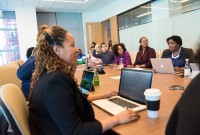- Home
- Business Processes
- Industry Knowledge
- Aerospace Industry
- Automotive Industry
- Banking Domain
- BFSI Industry
- Consumer/ FMCG Industry
- Chemicals Industry
- Engineering & Construction
- Energy Industry
- Education Domain
- Finance Domain
- Hospitality Domain
- Healthcare Industry
- Insurance Domain
- Retail Industry
- Travel and Tourism Domain
- Telecom Industry
- Leadership Skills
- eLearning
- Home
- Leadership
- Leadership Theories
- Contingency Theories in Action
Contingency Theories in Action
Contingency theory suggests matching the best leader to a specific situation based on situational factors and the leadership style. The practical application of theory can be done in various ways. The workplace example is to determine the best candidate for a given set of requirements using the LPC score. Applying the model to determine a leader's ability to adapt in the scenario of a new project etc..
Recap of Learnings from Contingency Theory:
Fielder’s contingency theory matches the leader to the situations by using the Least Preferred Co-Worker (LPC) model. A leader can perform effectively in certain roles and exhibit weakness in different situations based on three variables defined in the earlier article which predicts the favorability of the situation, while the leader’s LPC score determines the ability to function in the required task.
One can make use of the contingency theory to determine the best candidate for a given set of job requirements for effectiveness of a person in that role as by measuring a leader’s LPC score and the three situational variables, one can predict whether the leader is going to be effective in a particular setting. By assessing these three situational variables, one can place any organizational context in one of the eight categories represented in previous article. Once the nature of the situation is determined, the fit between the leader’s style and the situation can be evaluated.
Key Strengths of Contingency Theory:
1. Contingency theory is grounded in research as many researchers have tested it and found it to be a valid and reliable approach to explaining how effective leadership can be achieved.
2. This theory considers the impact of situations on leaders and focuses on the relationship between the leader’s style and the demands of various situations.
3. Third, contingency theory has predictive power and based on conclusions from LPC scale and understanding the context of the workplace situation one can determine the probability of success for a given person in a given situation.
4. From an organizational perspective it supports identification of optimal roles based on individual leadership styles and placing leaders in charge of situations that are ideal for their leadership style.
Practical Applications of the Theory:
Contingency theory has many applications in the organizational world:
1. Can be used to assess the effectiveness of an individual in a particular role and look at the reasons for one’s effectiveness or ineffectiveness.
2. Can be used to predict whether a person who has worked well in one position in an organization will be equally effective in another position having different situational variables when compared to the existing position based on the contingencies that make one’s style effective.
3. Can help in implementing changes in the roles and responsibilities that management might need to make to bring effectiveness to the role of the person leading the same.
Fiedler’s theory does not hold that leaders can adapt their styles to different situations as according to him personality is relatively stable. According to this model improving effectiveness involves changing the situation to fit the leader sometimes also referred to as “job engineering”.
As now we have more understanding of leadership and its challenges in the 21st century organizational context, contingency model might not be the best leadership model to use in most situations, but still can be a powerful tool to analyze a particular situation to determine whether to focus on tasks or relationships. This model sometimes can give an inaccurate picture of your leadership style as it relies heavily on the LPC scale, which has been questioned for its face validity and workability. Further this model does not fully explain how organizations can use the results of this theory in situational engineering and hence we recommend taking a cautious approach and using your own judgment to analyze the situation from all angles.
Related Links
You May Also Like
-
According to Environmental theories of leadership, a leader needs to deal effectively with environmental complexities and lead in a certain style as a result of environmental responses. Environmental influenced leadership demand leaders to learn how to adjust environmental factors. Leaders also have the responsibility of creating the right kind of environment for their followers by focusing on environmental factors and pressures.
-
University of Iowa Studies was the first leadership study to analyze leadership using scientific methodology. The study was conducted by Lewin, Lippitt, and White and worked on different styles of leadership. The studies explored three leadership styles - authoritarian, democratic, and laissez-fair leaders. This early study was very influential and established three major leadership styles.
-
Strategic Contingencies Theory is a theory of intra-organizational power. The power of a subunit or individual depends on a few contingencies and that the more contingencies are controlled by a subunit, the greater is its power. The theory focuses on tasks that need to be done in the form of problems to be solved, thus de-emphasizing personality.
-
Rensis Likert studied the patterns and styles of managers and developed four management systems known as Likert's management systems. These styles developed by him are known as Likert management systems. System 1 - Exploitative Authoritative; System 2 - Benevolent Authoritative; System 3 - Consultative and System 4 - Participative.
-
Situational Leadership - Application
Situational Leadership Theories are well known and frequently used for training leaders within organizations. Practical application is how to choose the right leadership approach for the situation. The theory emphasizes leader flexibility and advises leaders to flex their style based on the followers' needs. Leaders must adapt their leadership style to fit the prescribed task, understanding given situation/maturity of followers.
-
Attribution Theory of Leadership
The attribution theory of leadership deals with the formation of individual opinions about the reasons for particular events or observations. People will always try to understand why people do what they do. The leader will make a judgment about his employees based on his attribution of the causes of the employees' performance. Individuals will also make inferences about the leader and react to poor performance by the leader.
-
Contingency Theories of Leadership
Contingency theories of leadership focus on both the leader's persona as well as the situation/environment in which that leader operates. These theories consider the context of leadership which means whether or not the leadership style suits a particular situation and states that a leader can be effective in one circumstance and a failure in another one. A leader will be most effective when he applies the right leadership style to a given situation and environment around him. Contingent leaders are flexible and adaptable.
-
Authentic leadership is a new approach to leadership in which leaders are genuine, self-aware, transparent, build honest relationships, and work on an ethical foundation. Authenticity is one of the core values of leadership. Authentic leaders have truthful self-concepts and they inspire by promoting openness by acting in a real, genuine, and sincere way. Authenticity requires self-awareness and the ability to act in accordance with one's true self.
-
Trait Theory of Leadership is based on the assumption that people are born with inherited traits and some traits are particularly suited to leadership. The theory aims to discover specific leadership & personality traits and characteristics proven to predict the likelihood of success or failure of a leader.
-
In this study of power, Raven identified five bases of power as coercive, reward, legitimate, referent, and expert. The 5 Types of Power can help you decide when it is appropriate to use a particular type of power in important situations. Leadership involves authority and it is very important for leaders to understand what type of power they're using.
Explore Our Free Training Articles or
Sign Up to Start With Our eLearning Courses

About Us
Learning
© 2023 TechnoFunc, All Rights Reserved










